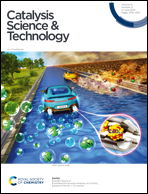Transformation of titanium carbide into mesoporous titania for catalysed HBr oxidation†
Abstract
Herein, we report TiC as precursor of a highly active and novel TiO2–TiC composite for the catalytic oxidation of HBr into Br2, which is a key technology for bromine looping in the halogen-mediated process for natural gas valorisation. In addition, we investigate the mechanism of TiO2 formation that is pivotal in deriving synthesis–structure–performance relationships. In-depth material characterisation, by means of X-ray diffraction, thermogravimetric analysis, N2 sorption, Raman, X-ray photoelectron, 47,49Ti and 13C nuclear magnetic resonance spectroscopies, as well as ex situ and in situ transmission electron microscopy reveal that the transformation of TiC proceeds via a combination of shrinking core and spot-oxidation mechanisms. This results in the formation of a TiO2–TiC composite, containing both anatase and rutile polymorphs, with enhanced mesoporosity, reaching up to a one order of magnitude higher surface area and pore volume compared to pristine TiC. Reactivity and kinetics studies are performed in HBr oxidation, showing that the catalyst activity follows a volcano behaviour, whose apex is found for the material calcined at 673 K. Its performance surpasses that of benchmark TiO2-P25 and is also found stable for 25 h on stream. Accordingly, the reactivity of the TiO2–TiC composite is rationalized based on the TiO2 generation and porosity formation, which are both functions of the oxidation temperature.



 Please wait while we load your content...
Please wait while we load your content...